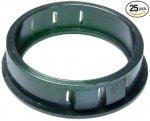busman
Senior Member
- Location
- Northern Virginia
- Occupation
- Master Electrician / Electrical Engineer
I'm trying to replace a 4 ft. fluorescent light in a customer's kitchen with a 4 ft LED light. Problem is, they all seem to have the wires exit the back of the fixture thru a 7/8" or even smaller hole for connection to the JB, which seems to be a clear violation of 410.24B (2014 NEC). How are these things getting UL listed. Am I missing something?
Please let me know if I need to add a photo to make this clear.
Thanks in advance. You are all a great resource.
Mark

Please let me know if I need to add a photo to make this clear.
Thanks in advance. You are all a great resource.
Mark


